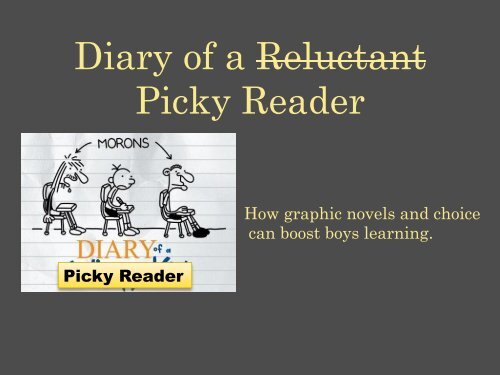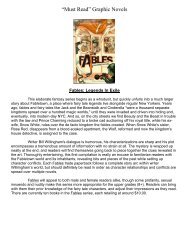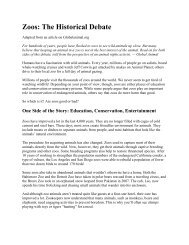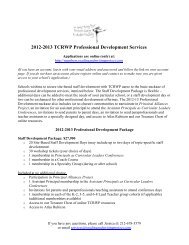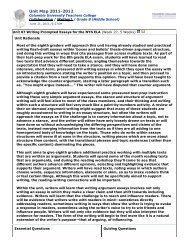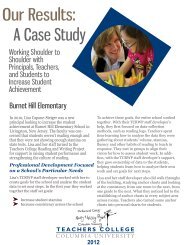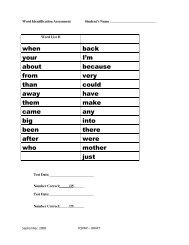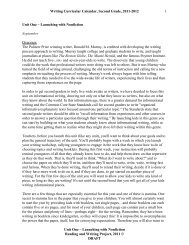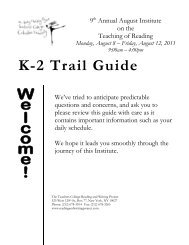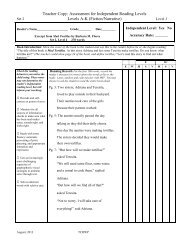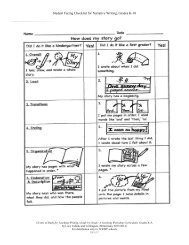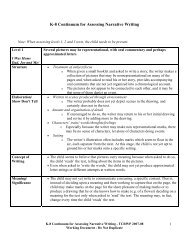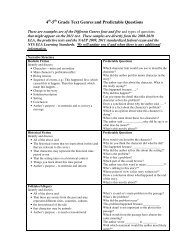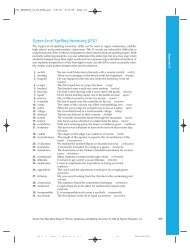Diary of a Reluctant Picky Reader - The Reading & Writing Project
Diary of a Reluctant Picky Reader - The Reading & Writing Project
Diary of a Reluctant Picky Reader - The Reading & Writing Project
Create successful ePaper yourself
Turn your PDF publications into a flip-book with our unique Google optimized e-Paper software.
What Does This Mean? Give them experiences with many different types <strong>of</strong> books Seek out quality books for boys Make it social and purposeful Make reading fun and engaging Help build confidence in our readers Boys need male literacy role models!
Common Books that Boys Enjoy Books that are plot and ac
LOOKING FOR CRAFTAND STRUCTURE,ALONG WITHCOMPREHENSIONLOOKING FOR CCSSCONNECTIONS
<strong>Reading</strong> Standards for Literature K–5Grade 3 students:Grade 4 students:Key Ideas and Details1. Ask and answer questions to demonstrateunderstanding <strong>of</strong> a text, referring explicitly to to thetext as the basis for the answers.1. 1. Refer to to details and and examples in in a a text text whenexplaining what the the text text says says explicitly and and when whendrawing inferences from the the text. text.2. Recount stories, including fables, folktales, and2. 2. Determine a a theme <strong>of</strong> <strong>of</strong> a a story, story, drama, or or poem poemmyths from diverse cultures; determine thefrom details in in the the text; text; summarize the the text. text.central message, lesson, or moral and explainhow it is conveyed through key details in in the the text. text.1. 1.2. 2.3. Describe characters in in a story story (e.g., (e.g., their their traits, traits,motivations,motivations, oror feelings)feelings) andand explainexplain howhow theirtheiractionsactions contributecontribute toto thethe sequencesequence <strong>of</strong><strong>of</strong> events.events.CraftCraft andand StructureStructure4. Determine the meaning <strong>of</strong> words and phrases as4. Determine the meaning <strong>of</strong> words and phrases asthey are used in text, distinguishing literal fromthey are used in a text, distinguishing literal fromnonliteral language.nonliteral language.5. Refer to parts <strong>of</strong> stories, dramas, and poems5. Refer to parts <strong>of</strong> stories, dramas, and poemswhen writing or speaking about text, usingwhenterms writing orsuch as speakingchapter, aboutscene, aand text,stanza;usingtermsdescribe such howas eachchapter, successivescene, and partstanza;builds ondescribeearlier sections.how each successive part builds onearlier sections.6. Distinguish their own point <strong>of</strong> view from that <strong>of</strong>6. Distinguish the narrator their or those own <strong>of</strong> point the <strong>of</strong> characters.view from that <strong>of</strong>the narrator or those <strong>of</strong> the characters.Integration <strong>of</strong> Knowledge and Ideas3. 3. Describe Describe in in depth depth a a character, character, setting, setting, or or event eventinin aa storystory oror drama,drama, drawingdrawing onon specificspecific detailsdetailsinin thethe texttext (e.g.,(e.g., aa character’scharacter’s thoughts,thoughts, words,words, ororactions).actions).4. Determine the meaning <strong>of</strong> words and phrases4. Determine the meaning <strong>of</strong> words and phrasesas they are used in a text, including thoseas they are used in a text, including thosethat allude to significant characters found inthat allude to significant characters found inmythology (e.g., Herculean).mythology (e.g., Herculean).5. Explain major differences between poems,5. Explain major differences between poems,drama, and prose, and refer to the structuraldrama,elements and prose,<strong>of</strong> poems and(e.g., refer toverse, therhythm, structuralmeter)andelements drama<strong>of</strong> (e.g.,poems casts(e.g., <strong>of</strong> characters,verse, rhythm, settings,meter)descriptions,and drama (e.g., dialogue,casts stage<strong>of</strong> characters, directions)settings,whenwritingdescriptions, or speakingdialogue, aboutstage a text.directions) whenwriting or speaking about a text.6. Compare and contrast the point <strong>of</strong> view from which6. different Compare stories and contrast are narrated, the point including <strong>of</strong> view the from difference whichbetween different first- stories and are third-person narrated, including narrations. the differencebetween first- and third-person narrations.3. 3.4.4.5.5.6.6.
<strong>Reading</strong> Standards for Literature K–56. Distinguish their own point <strong>of</strong> view from that <strong>of</strong>the narrator or those <strong>of</strong> the characters.Grade 3 students:Integration Key Ideas and <strong>of</strong> Knowledge Details and Ideas3. from Describe a series). characters in a story (e.g., their traits,motivations, or feelings) and explain how theiractions contribute to the sequence <strong>of</strong> events.10. By the end <strong>of</strong> the year, read and comprehendCraft literature, and Structure including stories, dramas, and poetry,4. at Determine the high end the meaning <strong>of</strong> the grades <strong>of</strong> words 2–3 and text phrases complexity asband they are independently used a text, and distinguishing pr<strong>of</strong>iciently. literal fromnonliteral language.writing or speaking about a text.6. Compare and contrast the point <strong>of</strong> view from whichdifferent stories are narrated, including the differencebetween first- and third-person narrations.Grade 4 students:7. 1. Explain Ask and how answer specific questions aspects to <strong>of</strong> demonstrate a text’s1. 7. Refer Make to connections details and between examples the in a text text <strong>of</strong> when a story 1. 7.illustrations understanding contribute <strong>of</strong> a text, to referring what is conveyed explicitly to theby text the as words the basis in a for story the (e.g., answers. create mood,explaining or drama and what a the visual text or says oral explicitly presentation and <strong>of</strong> whendrawing the text, inferences identifying from where the each text. version reflects2.8.emphasize aspects <strong>of</strong> a character or setting).Recount stories, including fables, folktales, and(Not myths applicable from diverse to literature) cultures; determine the2.8.specific descriptions and directions in the text.Determine a theme <strong>of</strong> a story, drama, or poemfrom (Not details applicable in the to text; literature) summarize the text.2.8.9.central message, lesson, or moral and explainCompare and contrast the themes, settings, and 9. Compare and contrast the treatment <strong>of</strong> similarhow it is conveyed through key details in the text.plots <strong>of</strong> stories written by the same author about themes and topics (e.g., opposition <strong>of</strong> good and9.the same or similar characters (e.g., in booksevil) and patterns <strong>of</strong> events (e.g., the quest) inRange <strong>of</strong> <strong>Reading</strong> and Level <strong>of</strong> Text Complexity3. Describe stories, myths, in depth and a character, traditional setting, literature or event fromin different a story or cultures. drama, drawing on specific detailsin the text (e.g., a character’s thoughts, words, oractions).10. By the end <strong>of</strong> the year, read and comprehendliterature, including stories, dramas, and poetry, in4. Determine the grades the 4–5 meaning text complexity <strong>of</strong> words band phrases pr<strong>of</strong>iciently,as with they scaffolding are used in as a needed text, including at the high those end <strong>of</strong> thethatrange.allude to significant characters found inmythology (e.g., Herculean).3.4.6.105. Refer to parts <strong>of</strong> stories, dramas, and poemswhen writing or speaking about a text, usingterms such as chapter, scene, and stanza;describe how each successive part builds onearlier sections.6. Distinguish their own point <strong>of</strong> view from that <strong>of</strong>the narrator or those <strong>of</strong> the characters.5. Explain major differences between poems,drama, and prose, and refer to the structuralelements <strong>of</strong> poems (e.g., verse, rhythm, meter)and drama (e.g., casts <strong>of</strong> characters, settings,descriptions, dialogue, stage directions) whenwriting or speaking about a text.6. Compare and contrast the point <strong>of</strong> view from whichdifferent stories are narrated, including the differencebetween first- and third-person narrations.5.6.
ChallengingStructures
Wri@ng Using the books we love to guide our wri
Wri@ng Wri@ng Choice: Tips and Ideas for Free Collec
Some Graphic Novel Series – • Dragon Breath • Tin Tin • <strong>Diary</strong> <strong>of</strong> a Nerd King • Frankie Pickle • Owly • Journal <strong>of</strong> a Schoolyard Bully • Aldo Zelnick • Lunch Lady • Squish, <strong>The</strong> Super Amoeba • Star Wars • Adventure <strong>of</strong> Bean Boy • Saltwater Taffy • <strong>The</strong> Mouse Guard Series • Graphic Universe (publisher)
Creating Engaging and SocialOpportunities that Foster Fun andExcitement Within <strong>Reading</strong> and<strong>Writing</strong>
Boys are not homogeneous – <strong>The</strong>re is greater differences between boys than there are between boys and girls. Warning: <strong>The</strong> ideas discussed here do not apply to all boys, nor do they ONLY apply to boys.
Social Opportuni@es • Partnerships • Targeted goals – Tony and Jesus • Sidng close while reading – Miguel & Adam • Performing for each other • Wri@ng out short scripts • Ac@ng out the exci@ng and favorite scenes • Sharing not only our books but our thinking • Community book sharing boards • Peer-‐to-‐peer recommenda@ons – in a public place • Book trailers • Across classroom recommenda@ons once a month • Dialogue journals for wri@ng • Thoughts, wonderings, explana@ons, daily occurrences, hard to ask ques@ons, etc
Book Trailers <strong>The</strong> Hook – Something that will grab the listener’s ajen@on. Get them excited and interested. • A quote that you liked from the book • Read a scary/funny/exci@ng part <strong>of</strong> the book • Link the book to a movie • Ask a ques@on the listener’s can relate to (Example: Have you ever felt like the world was against you?) <strong>The</strong> Content -‐ Tell about the characters and/or the plot • Give the @tle <strong>of</strong> the book and author's name toward the beginning • Give a brief summary <strong>of</strong> the plot. • Men@on any interes@ng characters. <strong>The</strong> CliHanger: Leave the listener’s with wan@ng more so they will want to read the book to find out what happens. • End the commercial unresolved with something up in the air.
Modifica@ons Moving around -‐ Helping to talk -‐ What have you done?
Wri@ng Wri@ng Choice: Tips and Ideas for Free Collec
Wri@ng Who are the boys’ literacy models?


